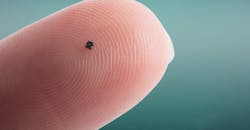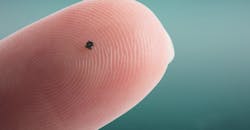Small IS Beautiful: Tiny Packages Help Designers Do More with Less (.PDF Download)
It’ll come as no surprise to any savvy buyer, and certainly not to any design engineer, that each new generation of electronic products packs more performance into a smaller package than the product it replaced (Fig. 1). No matter whether it’s a remote industrial sensor node or the next smart wearable device, space is becoming an increasingly scarce resource.
1. Better not sneeze: Aimed at IoT and personal electronics applications, the TLV9061 consumes only 0.64mm2 and is the world’s smallest op amp. (Source: Texas Instruments)
Something’s gotta give. In this case, many things. Fitting the increased capability into a smaller volume requires the designer to make improvements in multiple areas. The three biggest keys to succeeding, however, are to reduce the overall power consumption to allow the use of a smaller battery; integrate multiple functions into a single package to cut down on the number of devices; and choose individual components in the smallest available packages.
Manufacturers of both active and passive devices are keenly aware of the push toward smaller sizes. Just look at resistors, for example. Back in the old days before surface-mount technology (SMT), the standard small-signal resistor was a 1/8-W axial through-hole device measuring about 1.8 mm in diameter and 3.0 mm long, plus extra for the leads. The equivalent now is the 0201 surface-mount resistor. Yes, it only handles 50 mW, but it measures 0.3 × 0.6 mm, a reduction in area of 96%.
Integrated circuits are following a similar path. In some cases, manufacturers can reduce the overall size of their products by integrating more functions into a single part. Even single-function devices, though, such as op amps and LDO regulators, are undergoing some serious shrinkage—from leaded dual-inline packages to SOICs to SOT, and below. Traditional packages are much larger than the die they contain, as they must also house the lead frame, the bond wires, etc.

